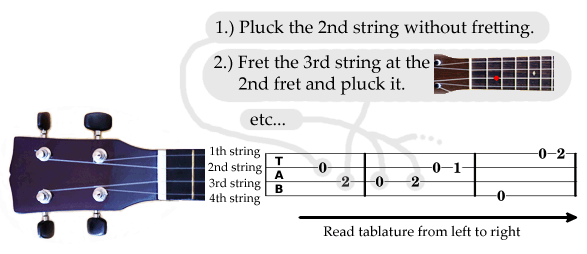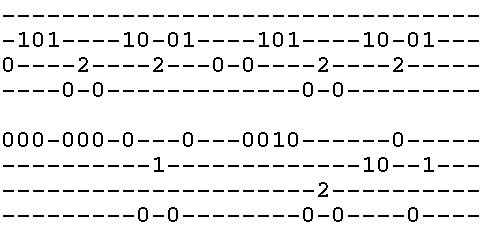Simple tablature
One line for every string
The essential principle of tablature is really simple:
- Every string of the ukulele corresponds to one horizontal line in the tablature. This results in a system of four lines.
- This system is read from left to right.
- Wherever a note should be played on a certain string, a number is written on the line corresponding to this string.
- This number indicates how the note should be played:
- The number 0 (zero) indicates, that the string should only be plucked, but not fretted.
- Numbers larger than 0 indicate the number of the fret, where the string should be fretted while plucking it.
ASCII tablature
The maybe simplest type of tablature is ASCII tablature. It can be written with any text editor by entering digits and dashes, however a character set with fixed character width should be used (for example Courier). Here an example:
In ASCII tabs, every horizontal character position corresponds to a fixed time interval. So, when playing, imagine an even pulse, advancing one character position with every beat. This is a really straightforward way of representing the temporal order of notes in a simple piece of music.
Polyphony
It is easy to represent polyphony with tablature. Notes that should be played at the same time are arranged one above the other, each on the line of the string that should be plucked to play it.
Why tablature anyway?
Of course there exist tablatures not only for ukuleles, but also for many other instruments like guitars, lutes, etc… The common concept of all tablature systems is to represent in a simple way how to play a piece on a certain instrument. For ukulele with re-entrant tuning this is much more important than for guitar. On guitar, due to the linear tuning, the notation alone is usually sufficient to understand which strings should be played. But on ukulele, the re-entrant tuning makes this much more difficult! So tablature can be really helpful. Another thing to be mentioned is, that in some cases, the arranger wants a certain (unusual) string to be played in order to achieve a desired sound.
If there are only few ambiguous places in a piece of music, tablature is not absolutely nessecary. However, complex arrangements tend to be ambiguous at many places. Thus the only sensible way of representing such arrangements is tablature.
Last not least, it is easier to sight-read tablature than notation — especially for beginners.




 English
English  Deutsch
Deutsch